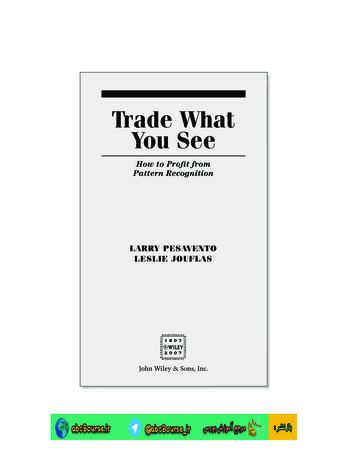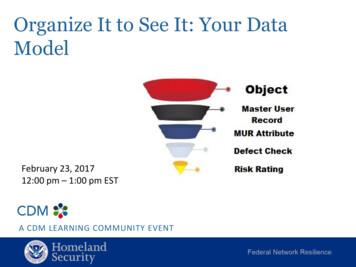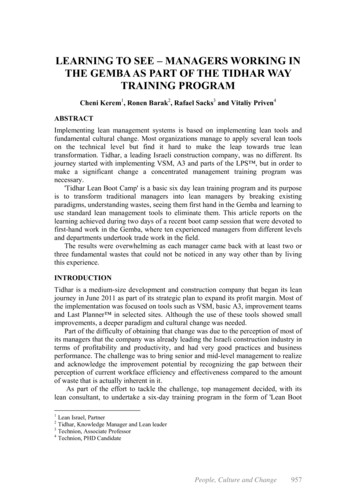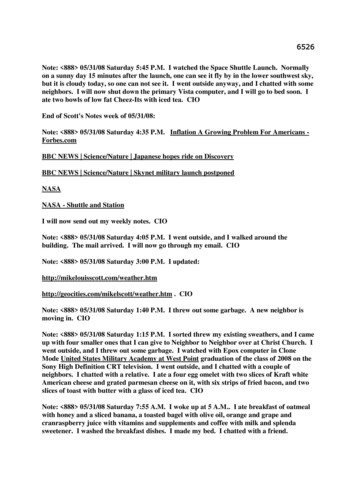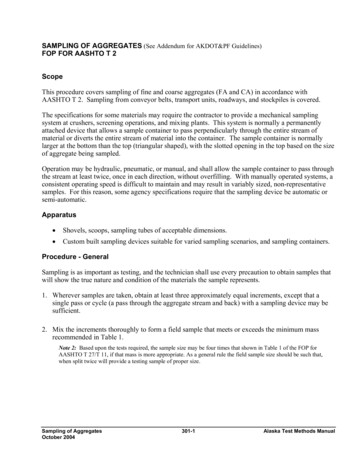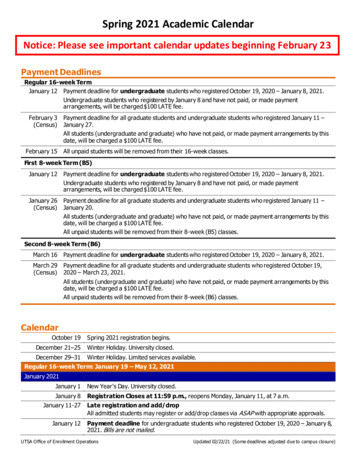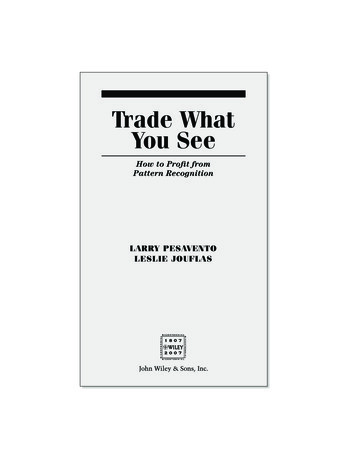
Transcription
JWPR033-FMJWPR033-Pesavento (Wiley Trading Series)August 31, 200712:52Trade WhatYou SeeHow to Profit fromPattern RecognitionLARRY PESAVENTOLESLIE JOUFLASChar Count 0
JWPR033-FMJWPR033-Pesavento (Wiley Trading Series)August 31, 200712:52Char Count 0
JWPR033-FMJWPR033-Pesavento (Wiley Trading Series)August 31, 200712:52Trade WhatYou SeeChar Count 0
JWPR033-FMJWPR033-Pesavento (Wiley Trading Series)August 31, 200712:52Char Count 0Founded in 1807, John Wiley & Sons is the oldest independent publishing company in the United States. With offices in North America, Europe,Australia and Asia, Wiley is globally committed to developing and marketingprint and electronic products and services for our customers’ professionaland personal knowledge and understanding.The Wiley Trading series features books by traders who have survivedthe market’s ever-changing temperament and have prospered—some byreinventing systems, others by getting back to basics. Whether a novicetrader, professional or somewhere in between, these books will provide theadvice and strategies needed to prosper today and well into the future.For a list of available titles, please visit our Web site at www.WileyFinance.com.
JWPR033-FMJWPR033-Pesavento (Wiley Trading Series)August 31, 200712:52Trade WhatYou SeeHow to Profit fromPattern RecognitionLARRY PESAVENTOLESLIE JOUFLASChar Count 0
JWPR033-FMJWPR033-Pesavento (Wiley Trading Series)August 31, 200712:52Char Count 0C 2007 by Larry Pesavento and Leslie Jouflas. All rights reserved.Copyright Published by John Wiley & Sons, Inc., Hoboken, New JerseyPublished simultaneously in Canada.Wiley Bicentennial Logo: Richard J. PacificoNo part of this publication may be reproduced, stored in a retrieval system, or transmitted in anyform or by any means, electronic, mechanical, photocopying, recording, scanning, or otherwise,except as permitted under Section 107 or 108 of the 1976 United States Copyright Act, withouteither the prior written permission of the Publisher, or authorization through payment of theappropriate per-copy fee to the Copyright Clearance Center, Inc., 222 Rosewood Drive, Danvers,MA 01923, (978) 750-8400, fax (978) 646-8600, or on the web at www.copyright.com. Requests tothe Publisher for permission should be addressed to the Permissions Department, John Wiley& Sons, Inc., 111 River Street, Hoboken, NJ 07030, (201) 748-6011, fax (201) 748-6008, or onlineat http://www.wiley.com/go/permissions.Limit of Liability/Disclaimer of Warranty: While the publisher and author have used theirbest efforts in preparing this book, they make no representations or warranties with respectto the accuracy or completeness of the contents of this book and specifically disclaim anyimplied warranties of merchantability or fitness for a particular purpose. No warranty may becreated or extended by sales representatives or written sales materials. The advice and strategiescontained herein may not be suitable for your situation. You should consult with a professionalwhere appropriate. Neither the publisher nor author shall be liable for any loss of profit or anyother commercial damages, including but not limited to special, incidental, consequential, orother damages.For general information on our other products and services or for technical support, pleasecontact our Customer Care Department within the United States at (800) 762-2974, outside theUnited States at (317) 572-3993 or fax (317) 572-4002.Wiley also publishes its books in a variety of electronic formats. Some content that appearsin print may not be available in electronic books. For more information about Wiley products,visit our web site at www.wiley.com.Library of Congress Cataloging-in-Publication Data:Pesavento, Larry.Trade what you see : how to profit from pattern recognition / LarryPesavento, Leslie Jouflas.p. cm. – (Wiley trading series)Includes index.ISBN 978-0-470-10676-1 (cloth)1. Speculation. 2. Stocks. 3. Investment analysis. 4. Fibonacci numbers.I. Jouflas, Leslie, 1957– II. Title.HG6041.P382 2008332.63 228–dc222007034476Printed in the United States of America10 9 8 7 6 5 4 3 2 1
JWPR033-FMJWPR033-Pesavento (Wiley Trading Series)August 31, 200712:52Char Count 0To all traders, past and present, who have dedicated themselves tobecoming successful at making a living in the profession of trading.
JWPR033-FMJWPR033-Pesavento (Wiley Trading Series)August 31, 200712:52Char Count 0
JWPR033-FMJWPR033-Pesavento (Wiley Trading Series)August 31, 200712:52Char Count 0ContentsPrefacexiAcknowledgmentsxvAbout the AuthorsxviiPART ONECHAPTER 1Introduction to Trading withPattern RecognitionOpening Thoughts3How to Use This Book3Succeeding or Failing in Trading4Steps to Take for Successful Trading7CHAPTER 2Geometry of the Patterns and FibonacciRatios9History of Geometry in the Markets11Fibonacci Ratios12Applying the Fibonacci Ratios16Summary18CHAPTER 3Harmonic Numbers and How to Use Them19Where the Term Harmonic Numbers Originated19Defining a Harmonic Number20Vibrations in Price Swings21Repetition in Price Swings24vii
JWPR033-FMJWPR033-Pesavento (Wiley Trading Series)August 31, 200712:52viiiChar Count 0CONTENTSFinding Harmonic Numbers28Harmonic Numbers Found in Other Markets34PART TWO The Price Patterns and How to Trade ThemCHAPTER 4The AB CD Pattern39History of the AB CD Pattern39AB CD Pattern Description41AB CD Pattern Structure41Important Characteristics of the AB CD Pattern44CD Leg Variations45Slope and Time Frames48Psychology of the AB CD Pattern50Trading the AB CD Pattern51CHAPTER 555The Gartley “222” PatternHistory of the Gartley “222” Pattern55Gartley “222” Pattern Description57Gartley “222” Pattern Structure58Important Characteristics of the Gartley “222” Pattern59Psychology of the Gartley “222” Pattern61Trading the Gartley “222” Pattern62CHAPTER 669The Butterfly PatternHistory of the Butterfly Pattern69Butterfly Pattern Description70Butterfly Pattern Structure72Important Characteristics of the Butterfly Pattern73Psychology of the Butterfly Pattern74Trading the Butterfly Pattern75CHAPTER 785The Three Drives PatternHistory of the Three Drives Pattern85Three Drives Pattern Description86
JWPR033-FMJWPR033-Pesavento (Wiley Trading Series)August 31, 200712:52Char Count 0ixContentsThree Drives Pattern Structure87Important Characteristics of the Three Drives Pattern88Psychology of the Three Drives Pattern89Trading the Three Drives Pattern89CHAPTER 8Retracement Entries and MultipleTime Frames95Fibonacci Retracement Entries96Fibonacci Retracement Pattern Structure96Trading the Fibonacci Retracement PatternOpening Price Retracement Setups98103Market Setup for the Opening Price Retracement Trade103Trading the Opening Price Retracement Setup105Multiple Time Frames108CHAPTER 9117Classical Technical Analysis PatternsA Brief History of Technical Analysis118Basics of Technical Analysis119Double Bottom and Top Patterns119Head and Shoulders Pattern125Broadening Top and Bottom Patterns130CHAPTER 10135Learning to Recognize Trend DaysIdentifying a Trend Day136Patterns Found on Trend Days139Fibonacci Ratios on Trend Days142Controlling Risk on a Trend Day144Trading a Trend Day145PART THREE Essential Elements of TradingCHAPTER 11Trade Management153Thinking in Probabilities154Warning Signs and Confirmation Signs155Money Management159
JWPR033-FMJWPR033-Pesavento (Wiley Trading Series)August 31, 200712:52xCHAPTER 12Char Count 0CONTENTSUsing Options with the Fibonacci Ratiosand Patterns165Call and Put Options Defined165Factors That Influence the Price of an Option166Controlling Risk with Options167Examples of Using Options with Extension Patterns168CHAPTER 13173Building a Trading PlanDaily Trading Plan174Trading as a Business180Disaster Plans183Summary187CHAPTER 14Daily Routines189Trade Preparation189Mental Preparation192Physical Preparation195Appendix197Index201
JWPR033-FMJWPR033-Pesavento (Wiley Trading Series)August 31, 200712:52Char Count 0Preface“Trading is a journey—not a destination.”Several hundred years ago, technical analysis began its journey to helpinvestors and traders determine, with reasonable probability, whatdirection prices might take. Technical analysis allows investors andtraders to identify moments of opportunity to profit in the markets. It doesso by identifying and quantifying specific patterns that form and repeat withenough regularity that trading methods and strategies can be developed andimplemented with success.Trade What You See: How to Profit from Pattern Recognition focuseson trading patterns with an underlying root structure based on simple geometric forms and Fibonacci ratios. The patterns are easily identifiable oncethe trader has spent some time observing and learning the basic structures.Each of these patterns can be quantified and a sound money managementstrategy applied.Writing a book about pattern recognition based on geometric patternsand Fibonacci ratios requires acknowledging the early scholars of geometry, including Pythagoras, Archimedes, and of course the great mathematician Leonardo di Pisa (better known as Fibonacci). These great scholarshad all traveled to Egypt during their lifetimes and had studied the GreatPyramids. Pythagoras, the father of modern geometry, was obsessed by themathematics of the pyramids. The actual mass of the structure was not asimportant to him as the fact that all of the angles on all sides were within .01percent. Part of the mystery of the Great Pyramids is how the mathematicsrelates to the golden ratio, which is also referred to as the divine proportion,or .618.It was not so many years ago that a book of this nature, based ontechnical analysis, would not have been taken seriously by many. We beginwith a look at a point in time when technical analysis had begun to takeroot in the academic community.xi
JWPR033-FMJWPR033-Pesavento (Wiley Trading Series)August 31, 2007xii12:52Char Count 0PREFACEVALIDATION FROM THE SCIENTIFICCOMMUNITYFor years technical analysis was shunned by many Wall Street professionals, looked upon as one step above tea leaf reading. A turning point occurredon April 17, 2000, when a paper by Dr. Andrew W. Lo of the MassachusettsInstitute of Technology (MIT) was published in BusinessWeek. The title ofthe article was “This Alchemy Will Yield Pure Gold.” The article substantiated and verified that indeed there is an edge in technical analysis after all.This, of course, did not surprise any market technician who had successfullybeen using pattern recognition.The article did, however, bring technical analysis from the age ofalchemy into the realm of academia. Princeton University Press publisheda book by Dr. Lo and A. Craig MacKinlay, A Non-Random Walk Down WallStreet, which analyzed why patterns work and how they repeat. This couldbe one of the reasons that the financial public is now exposed to so manychart patterns in the financial press and on television.Long before Lo and MacKinlay’s book was published, there were manygreat technical analysts to whom today we owe a debt of gratitude. Someof these technical analysts who have contributed groundbreaking work areH.M. Gartley, William Garrett, Edwards and McGhee, Frank Tubbs, R.W.Schabacker, William Dunnigan, Ralph Elliott, John Murphy, Linda Raschke,John Hill, Bryce Gilmore, Charles Lindsay, and Richard Wyckoff. We regretif we unintentionally omitted any famous names.What this book teaches is a simple, pragmatic approach to patternrecognition. It’s designed to be hands-on and to appeal to new studentsof technical analysis as well as seasoned traders.The motto that we trade by is “Trade what you see, not what you believe.” A true technician is interested only in price bars and the summationof these price bars—the only truth in trading. Traders must learn to believein what the market is telling them based on price. This is best accomplishedby studying price behavior through pattern recognition.OVERVIEW OF THE BOOKThis book was written to give the reader a comprehensive view of the specific patterns presented. We use a variety of stocks and markets in the chartexamples throughout the book to illustrate that these particular patternsdo form in all markets, and in all time frames. We present patterns derivedfrom some of the classic technical analysis patterns as well as the geometryand Fibonacci-based patterns. Here is an overview of each chapter:
JWPR033-FMJWPR033-Pesavento (Wiley Trading Series)PrefaceAugust 31, 200712:52Char Count 0xiiiChapter 1: Opening Thoughts—We give the reader some of our observations on what is needed to successfully use the information in this book.We also offer our insights after dealing with hundreds of traders on whatcan make a successful trader and also what leads to failure.Chapter 2: Geometry of the Markets and Fibonacci Ratios—Thischapter covers the simple geometry of the markets and how the x-axisand y-axis provide just another way of illustrating triangles. We also coverthe history of Fibonacci ratios and present the ones we apply to ourtrading.Chapter 3: Harmonic Numbers and How to Use Them—This chaptershows that all financial markets have what we refer to as harmonic andrepetitive swings that are inherent in each particular market. This chapterbegins to outline the basic structure of each pattern.Chapter 4: The AB CD Pattern—The AB CD pattern is one of the simplest to identify in any market, on any time frame, and is the basis ofseveral other patterns presented.Chapter 5: The Gartley “222” Pattern—Derived from Gartley’s work inthe 1930s, this pattern is a classic retracement pattern.Chapter 6: The Butterfly Pattern—The Butterfly pattern is seen at extreme turning points in tops and bottoms; it is ideal for options tradesand allows low-risk entries.Chapter 7: Three Drives Pattern—This pattern can signal either a majorturning point or a more complex correction in a trend. It is very easy tosee on a price chart when it forms.Chapter 8: Retracement Entries and Multiple Time Fram
Pesavento, Larry. Trade what you see : how to profit from pattern recognition / Larry Pesavento, Leslie Jouflas. p. cm. – (Wiley trading series) Includes index. ISBN 978-0-470-10676-1 (cloth) 1. Speculation. 2. Stocks. 3. Investment analysis. 4. Fibonacci numbers. I. Jouflas, Leslie, 1957– II. Title. HG6041.P382 2008 332.63 . 228–dc22 2007034476 Printed in the United States of America .
